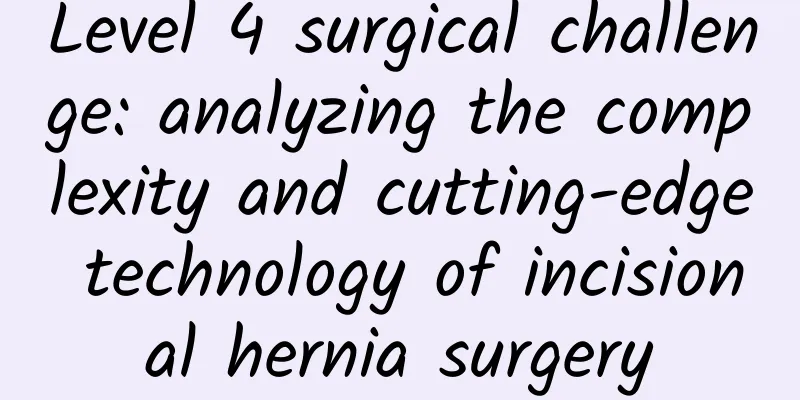Level 4 surgical challenge: analyzing the complexity and cutting-edge technology of incisional hernia surgery

|
Author: Zhu Tong, attending physician, Beijing Chaoyang Hospital, Capital Medical University Reviewer: Shin Youngmo, Chief Physician, Beijing Chaoyang Hospital, Capital Medical University In surgical operations, incisional hernia is a common postoperative complication in the field of abdominal surgery, and its treatment and care have always been the focus of medical attention. Unlike the inguinal hernia (commonly known as "small intestinal hernia") that is often mentioned in daily life, the treatment of incisional hernia has certain complexity and potential risks, and its treatment requires more rigorous and sophisticated diagnosis and treatment strategies. Incisional hernia, as the name implies, refers to a hernia that occurs at the incision of the abdominal wall during surgery. Its formation is mostly caused by poor incision healing, reduced abdominal wall strength, and increased intra-abdominal pressure. According to the surgical classification standards, incisional hernia is a level 4 operation. This rating is not only due to its high surgical difficulty, but also due to the many risks and intraoperative uncertainties in the treatment process. Unlike the day surgery model for inguinal hernia, most incisional hernia surgeries require general anesthesia, and patients often have multiple underlying diseases and postoperative complications, which undoubtedly increases the difficulty and risk of the operation. The complexity of incisional hernia surgery is mainly reflected in the following aspects: First, since adhesions of abdominal organs may exist at the surgical incision site, these adhesions need to be carefully separated during the operation to avoid damage to the solid and hollow organs; secondly, some incisional hernia surgeries may involve intestinal operations, such as dealing with intestinal adhesions, intestinal obstruction, etc., which requires the surgeon to have extremely high surgical operation skills and rich clinical experience; finally, observation and management of the postoperative recovery period are also crucial. The patient needs to go through a certain period of fasting and gastrointestinal function recovery to ensure the effectiveness of the operation. In the process of surgical treatment, patch repair has become an important means of treating incisional hernia. The selection and placement of the patch should be determined according to the specific situation of the patient. It can be divided into several repair methods, including Onaly (anterior intermuscular space patch repair), Inlay (intermuscular bridging patch repair), Sublay (anterior and posterior intermuscular space patch repair) and IPOM (intraperitoneal patch repair). Among the three methods of Onlay, Inlay and Sublay, the patch is placed in front of the peritoneum, which, as the last layer of the abdominal wall, plays a role in isolating the patch from the abdominal organs. IPOM is the only method that places the patch inside the abdominal cavity, which can be performed through open surgery or the more common laparoscopic minimally invasive technique, with the advantages of less trauma, faster recovery and lower postoperative recurrence rate. Figure 1 Original copyright image, no permission to reprint Conservative treatment is also important for elderly patients with incisional hernia who are in poor general condition and cannot tolerate surgery. The core of conservative treatment is to reduce abdominal pressure and reduce the protrusion of hernia contents, thereby avoiding the progression of incisional hernia and the occurrence of hernia-related complications. Specific measures mainly include abdominal belt compression, weight control, active treatment of primary underlying diseases (such as cough variant asthma, chronic obstructive pulmonary disease, etc.), and avoiding factors that sharply increase abdominal pressure (such as weight bearing, constipation, severe coughing, etc.). As an important tool in conservative treatment, the use of the abdominal belt must also follow certain principles. The abdominal belt should be worn in a supine position to avoid compressing the herniated intestine when standing or moving; at the same time, the abdominal belt should be removed at night to avoid excessive compression that affects cardiopulmonary function. In addition, the tightness of the abdominal belt should also be adjusted appropriately according to the patient's comfort and treatment effect. Figure 2 Original copyright image, no permission to reprint With the continuous advancement of medical technology, the treatment of incisional hernia is also constantly innovating and improving. For example, for complex and difficult incisional hernias, doctors can use active volume reduction technology to remove excess fat, omentum, intestinal tissue, etc. to reduce abdominal pressure and improve the success rate of surgery. In addition, the emergence of new materials such as biological patches and composite patches also provides more options for the individualized treatment of incisional hernia. With the continuous development and popularization of minimally invasive technology, laparoscopic and robot-assisted surgery have broader application prospects in the treatment of incisional hernia. These minimally invasive methods can not only reduce the trauma and pain of patients, but also shorten the hospital stay and speed up the recovery, thereby improving the quality of life of patients. At the same time, with the continuous deepening of materials research, safer and more effective patch materials will continue to emerge, providing more solid support for the treatment of incisional hernia. |
>>: Four principles of correct muscle training...
Recommend
During pregnancy and delivery, how important is a pregnant woman’s good mood to the fetus?
Every parent has a common vision in their heart: ...
Why do I feel dizzy after the transplant?
In recent years, more and more people have been s...
Severe fungal vaginitis pictures
Women are very susceptible to fungal infections, ...
EMI: 2018 Teenagers’ Smartphone Addiction Survey Report
Smartphones have become an indispensable device f...
Women's joint pain when sleeping at night
Many people usually have symptoms such as joint p...
Sea salt, iodized salt, low sodium salt...how to choose among different types of salt?
When you go to the supermarket to buy salt, you w...
What should women do if they have insufficient blood and milk?
What should a woman do if she has insufficient qi...
How to maintain the uterus?
As a woman, once a disease occurs in the uterus, ...
At what age do girls get their first menstruation?
The first menstruation is also called the first m...
What are the long-term contraceptive methods for women?
For a period of time after marriage, many people ...
Breast pain when menstruation is approaching
There are many reasons for breast pain when menst...
Why does my vagina sometimes itch?
Probably every woman has experienced vaginal itch...
What is the normal thickness of the endometrium before menstruation?
The thickness of the endometrium changes over tim...
Can I soak my feet during my period?
In the cold winter, many people soak their feet b...









